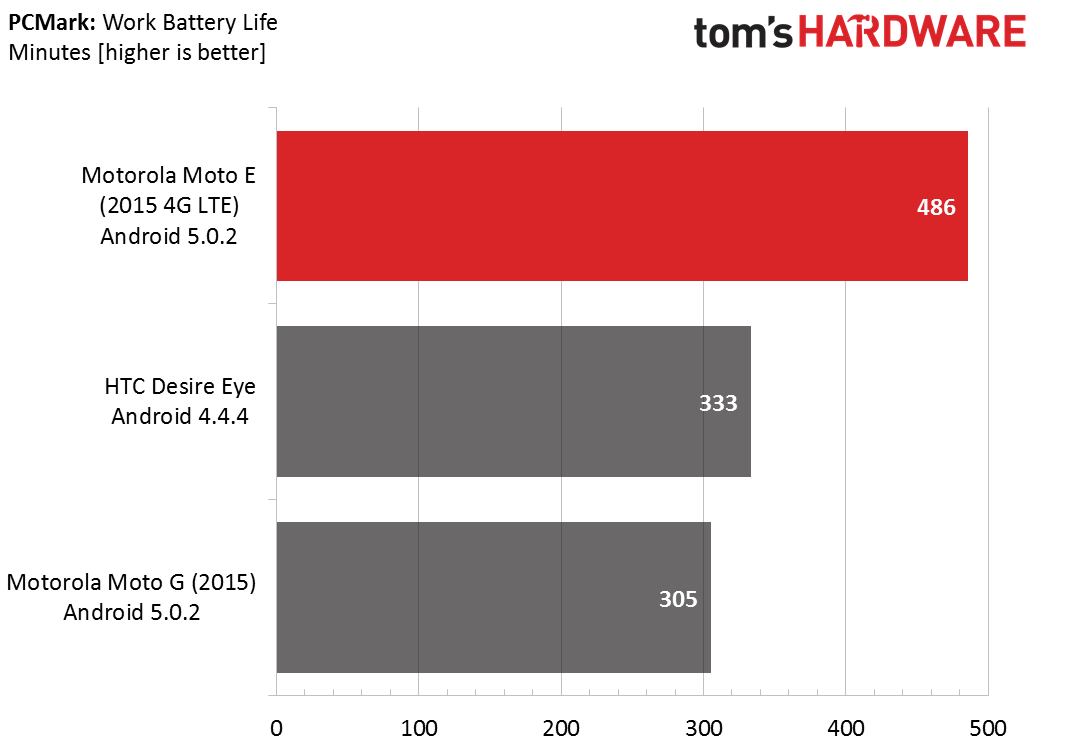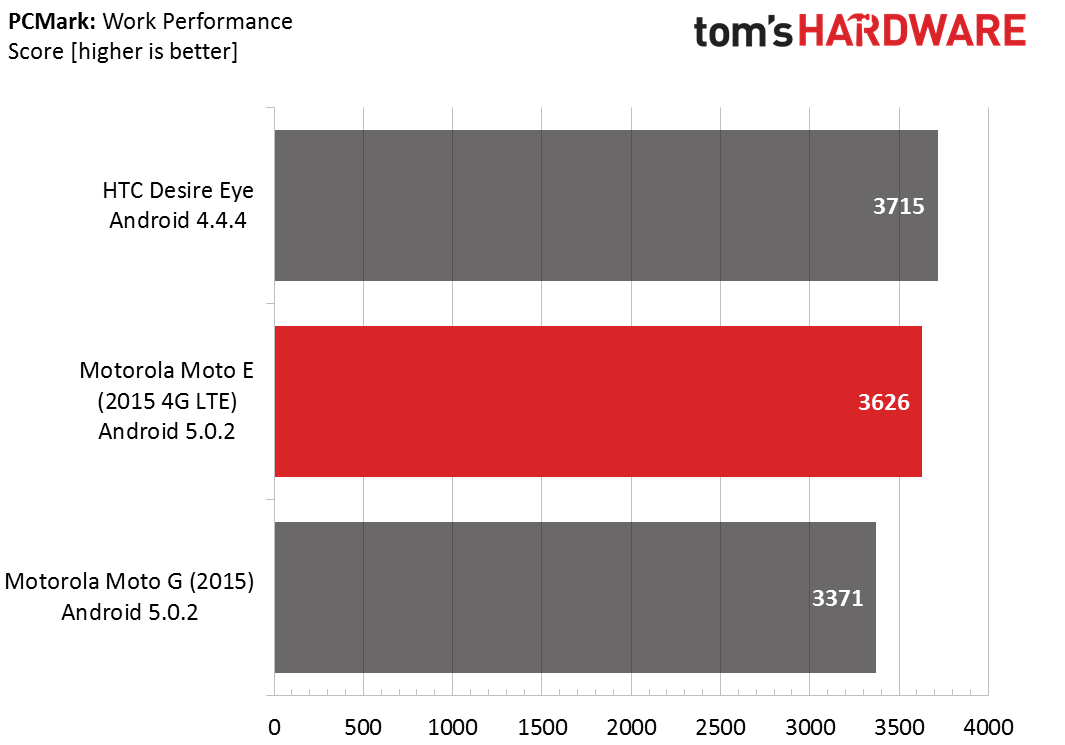Motorola Moto E (2nd Gen) Review
Motorola’s second generation Moto E receives significant enhancements, including a faster 64-bit SoC, front-facing camera, and bigger battery. There’s even an LTE option. Is this budget smartphone worth more than its bargain price?
Why you can trust Tom's Hardware
Battery Life And Thermal Throttling
Battery life may be the most important performance metric for a mobile device. After all, it does not matter how quickly a phone or tablet can load webpages or how many frames per second the GPU can crank through once the battery runs down and the device shuts off. To learn more about how we test this critical facet of mobile computing, please read our battery testing methodology article.


The Moto E (2nd gen) comes with a 2390mAh battery, which is 21% more capacity than the 1980mAh battery inside the original Moto E. This gives the Moto E a larger battery than both the second generation Moto G (2070mAh) and Moto X (2300mAh) as well as the Lumia 830 (2200mAh), all more expensive 5-inch class phones.
Combining a large battery with a smaller 4.5-inch display gives the Moto E just over 8 hours of battery life in PCMark, a 59% advantage over the Moto G. Not only does the Moto E last longer than the G on a charge, but it actually offers slightly better performance while doing so. While the Moto E lacks panel self refresh, which is a hardware feature that saves power when displaying a static screen, it does not seem to hold it back in this test.
The Basemark OS II battery test is sort of a worst case indicator of battery life under CPU intensive workloads. While the Moto E (2nd gen) fares better than the other devices we are comparing it to, it only outscores the Moto G (2nd gen) by 8.2%, far less than the 59% advantage we saw in the more realistic PCMark load cases, despite having a 15.5% larger battery and smaller screen.
Because this is primarily a CPU test, we can use it to get a rough estimate for the difference in power efficiency between the A7 and A53 cores running at the same frequency and built on the same 28nm LP process node. Comparing the difference in score to the difference in battery size shows that at a system power level, the Moto E is 7.3% less efficient than the Moto G. The Moto G’s system power draw will be slightly higher than the Moto E because of its larger screen, giving the A7 CPU core a greater than 7.3% performance per watt advantage over the A53 core (We did not get a baseline power draw before we had to return our evaluation units, but after accounting for the difference in screen size, this figure should be in the 10-20% range.). This tells us that ARM has reached a point of diminishing returns trying to get extra performance out of the narrow, in-order A7/A53 architecture, and probably why we do not see a new LITTLE core to accompany the A72.


In the GPU and gaming focused GFXBench 3.0 battery test, the Moto E keeps the fun going for 7.8 hours, which is more than double the 3.5 hours for the Moto G. The Moto E’s lower GPU frequency and resolution (this test is rendered onscreen) provide the edge in battery life. The lower resolution also helps with performance, allowing it to post better frame rates than the Moto G and Lumia 830.
The Adreno 330 in the HTC Desire Eye provides 1.8x the performance (after some thermal throttling) of the Moto E, but there’s a price to pay: it only lasts for ~3.5 hours compared to the 7.8 hours of the Moto E.
Get Tom's Hardware's best news and in-depth reviews, straight to your inbox.
The battery drain and performance graph from the GFXBench battery test shows no hint of thermal throttling over the 28 minute duration of the test, since the performance remains constant the whole time.
Using the device in the real world, it’s quite obvious that the latest Moto E has significantly better battery life than the Moto G (2nd gen). With moderate use it lasts about a day or more longer than the Moto G (so two or three days total). With light use it should last three or four days. If that’s not impressive enough, the device can easily last a week in idle mode.
As you can see above, even with 70% battery charge left, it should still last another week. However, it should be noted that the device was on minimum or less than half brightness levels the whole time.
The bottom line is that the Moto E (2nd gen) has great battery life. The combination of an efficient SoC (even if Cortex-A53 is slightly less efficient than Cortex-A7), a relatively low resolution, a small screen (at least by today’s standards), and a large battery gives the new Moto E the edge over most smartphones on the market.
Current page: Battery Life And Thermal Throttling
Prev Page GPU And Gaming Performance Next Page ConclusionLucian Armasu is a Contributing Writer for Tom's Hardware US. He covers software news and the issues surrounding privacy and security.
-
emad_ramlawi Lenovo k30-W for the winReply
all the above +
HD ready resolution 720p
internal storage 16GB
the only con, is there OS, which is good, but not really vanilla android -
atljsf i bought one and had to return it, it restarts while charging and motorola at this moment hasn't solved the problem, a shame because it is a nice fast phoneReply -
tekelymailcom The only international variant mentioned is the XT1505 but there are more. I found very interesting the XT1523 which has 16GB, dual sim and digital TV reciever.Reply -
HideOut There might be an error in the speaker/sound part above. "Plugging in a set of good headphones provides a similar listening experience. Relative to the iPhone 6, bass has less punch and the Moto E lacks clarity; the signal-to-noise ratio seems higher." The S/N ratio on the Moto E should be LOWER, not higher if it sounds like its lacking clarity.Reply -
HideOut There might be an error in the speaker/sound part above. "Plugging in a set of good headphones provides a similar listening experience. Relative to the iPhone 6, bass has less punch and the Moto E lacks clarity; the signal-to-noise ratio seems higher." The S/N ratio on the Moto E should be LOWER, not higher if it sounds like its lacking clarity.Reply -
MobileEditor ReplyThe S/N ratio on the Moto E should be LOWER, not higher if it sounds like its lacking clarity.
Good point. I must have been thinking of THD, which is expressed as a percent. I've made the necessary correction.
- Matt Humrick, Mobile Editor, Tom's Hardware -
Dr3amCast I also purchased this phone and experience the restart while charging issue. Also, the performance is on par with a very, very basic Lumia 510 I had the misfortunate of having to use for a short time. The phone chugs while multi-tasking. And I mean by just hitting the home screen instead of closing out of apps. And even that takes an inordinate amount of time. I'm talking a noticeable 3-4 seconds after you hit home: your background wallpaper shows up, but no icons or app try icon, then another second or 2 later the icons show up. It's performance is dreadful. As well is its 1GB of memory. If I'm in the car I use bluetooth and Google Play Music / Google Maps. If I begin navigating to a destination and begin playing music Maps will close. I'm assuming due to lack of sufficient RAM. If I'm at a stop light and open snapchat, Google Play Music, Maps or Waze will close if I view a Snap. It's really rather frustrating the more you use the device. And I don't have many apps on here at all. Essentially just FB, Twitter, Snapchat, Waze, WatchESPN, HBOGo. That's all. It's frustrating seeing reviews like these on this phone that don't actually put it through its paces for a decent amount of time.Reply -
MobileEditor ReplyI also purchased this phone and experience the restart while charging issue. Also, the performance is on par with a very, very basic Lumia 510 I had the misfortunate of having to use for a short time. The phone chugs while multi-tasking.
I'm sorry you had a poor experience, but thanks for taking the time to add your story. This is why we included the HTC Desire Eye in our performance evaluation, so our readers could see the performance delta between some lower-cost devices and last year's flagships running Snapdragon 801 SoCs, which are now considered mid-tier.
Our unit did not experience the restart while charging issue, and while this comes as no solace to you, the Moto E handled its 1GB of RAM better than the Lumia 830 did during our testing and evaluation.
- Matt Humrick, Mobile Editor, Tom's Hardware -
quadrider21 I've experianced BT connectivity problems with both the Moto G and this new Moto E when connected to various cars. I'd be wary purchasing these phones if you rely on BT connectivity in your cars.Reply


